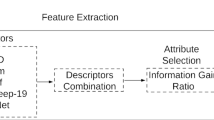Abstract
Various neural network models for the identification and classification of different skin lesions from ALA-induced fluorescence images are presented. After different image preprocessing steps, eigenimages and independent base images are extracted using PCA and ICA, respectively. In order to extract local information in the images rather than global features, Generative Topographic Map** is added to cluster patches of the images first and then extract local features by ICA (local ICA). These components are used to distinguish skin cancer from benign lesions. An average classification rate of 70% is obtained, which considerably exceeds the rate achieved by an experienced physician.
Access this chapter
Tax calculation will be finalised at checkout
Purchases are for personal use only
Preview
Unable to display preview. Download preview PDF.
Similar content being viewed by others
References
M.S. Bartlett, H. Martin Lades, Terrence J. Sejnowski. Independent component representations for face recognition. Proceedings of the SPIE Symposium on Electronic Imaging: Science and technology; Conference on Human Vision and Electronic III, San Jose, California, 1998
C.M. Bishop, M. Svensen, C.K.I. Williams. A Principle Alternative to the Self Organizing Map Advances in Neural Information Processing Systems, volume 9, 354–360, MIT Press, 1997b
J. Karhunen, S. Malaroiu. Local independent component analysis using clustering. International Workshop on Independent Component Analysis, Aussois, France, 1999
C. Mies, C. Bauer, G. Ackermann, W. Bäumler, C. Abels, R.M. Szeimies, E.W. Lang. Classification of Skin Cancer And Benign Lesions Using Idependent Component Analysis. Proceedings of ISI, Dubai, 2001
P. Pajunen, J. Karhunen. A Maximum Likelihood Approach to Nonlinear Blind Source Separation. Proceedings of the Int. Conf. on Artificial Neural Networks (ICANN’97), Lausanne, Switzerland, 1997
M. Turk, A. Pentland. Eigenfaces for Recognition. Journal of Cognitive Neuroscience, 3:71–86, 1991
H.H. Yang, S. Amari. Adaptive On-Line Learning Algorithms for Blind Separation-Maximum Entropy and Minimum Mutual Information. Neural Computation, 1997
Author information
Authors and Affiliations
Editor information
Editors and Affiliations
Rights and permissions
Copyright information
© 2001 Springer-Verlag Berlin Heidelberg
About this paper
Cite this paper
Mies, C. et al. (2001). Can ICA Help Classify Skin Cancer and Benign Lesions?. In: Mira, J., Prieto, A. (eds) Bio-Inspired Applications of Connectionism. IWANN 2001. Lecture Notes in Computer Science, vol 2085. Springer, Berlin, Heidelberg. https://doi.org/10.1007/3-540-45723-2_39
Download citation
DOI: https://doi.org/10.1007/3-540-45723-2_39
Published:
Publisher Name: Springer, Berlin, Heidelberg
Print ISBN: 978-3-540-42237-2
Online ISBN: 978-3-540-45723-7
eBook Packages: Springer Book Archive




